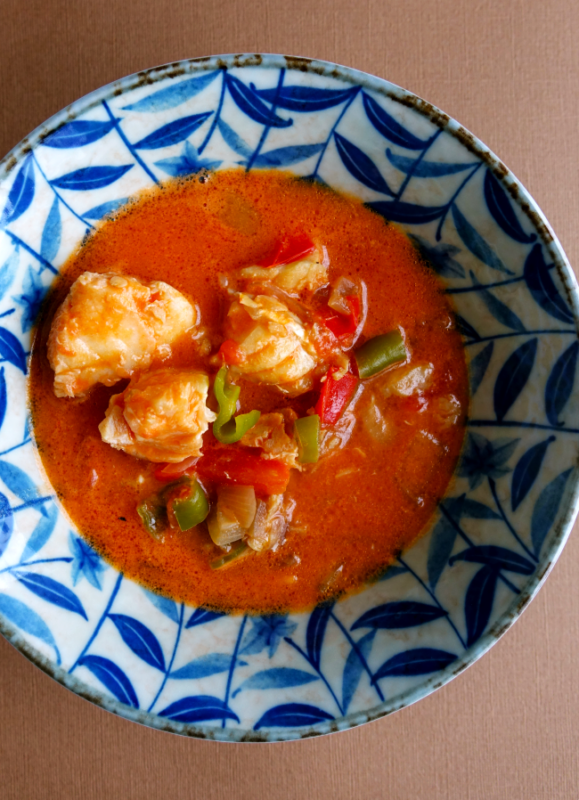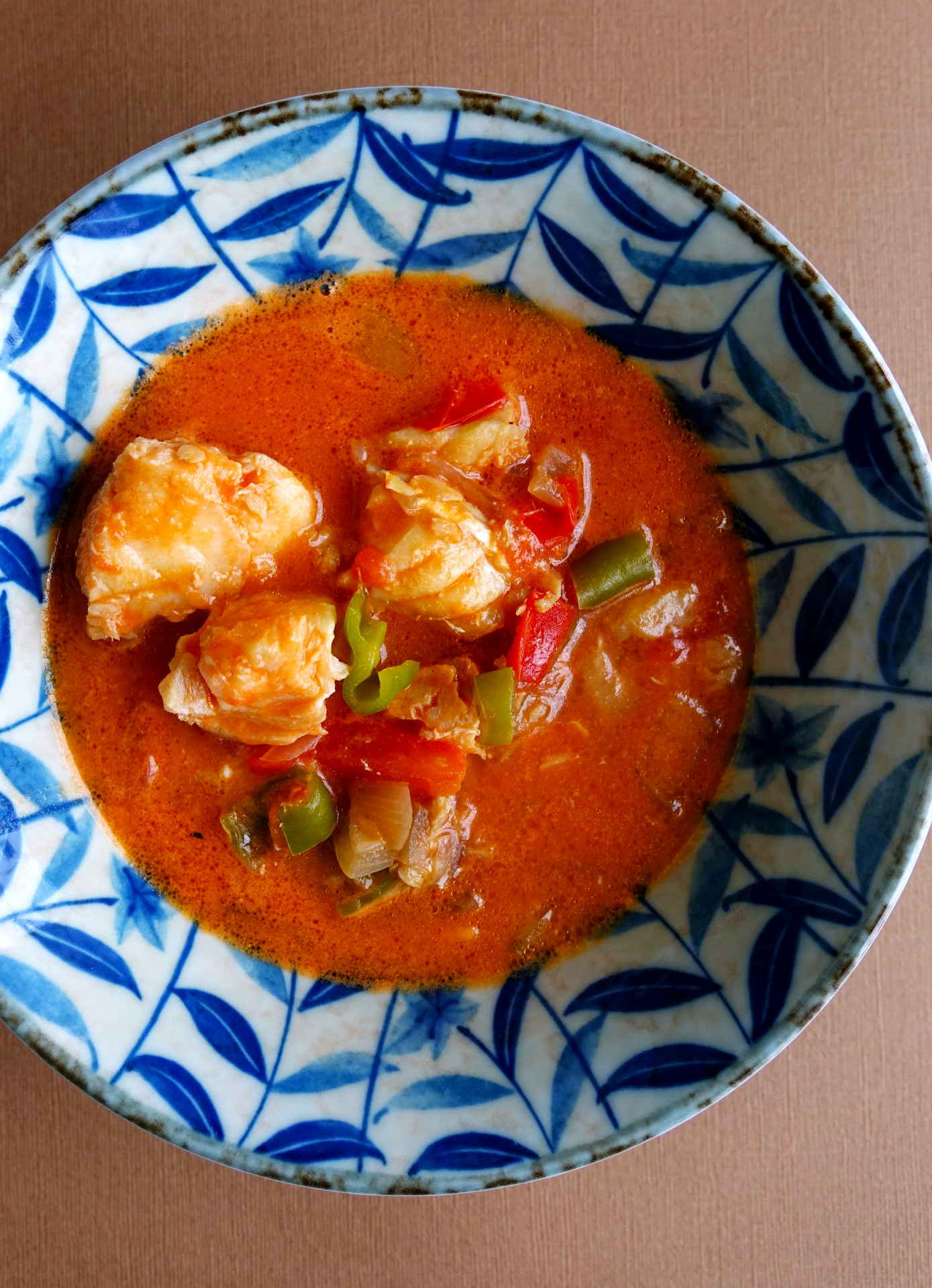Whip up this easy Thai fish soup recipe, a creamy and authentic Thai soup bursting with flavor. Tender white fish meets rich coconut milk and tangy tomatoes in this comforting Thai coconut fish soup. Perfect as a healthy main dish, it’s the best Thai fish soup for experiencing vibrant Thai cuisine at home.
- Two pounds of Grouper fish, or other kind of fish, sliced
- One stalk of lemongrass, cut into 2-inch pieces and smashed
- Two cloves of garlic minced
- One cooking onion, peeled and roughly chopped.
- Two tbsp. of Fish Sauce
- 300 grams of canned 50-60% coconut milk
- Two tbsps. of coconut oil
- One tomato diced
- Three tbsp. of lime juice
- One liter of water
- 30g finely grated or minced ginger root
- One long hot pepper or red chili pepper diced.
- 200 ml of tomato paste
- Salt to taste
- Large pot or wok: Large volume cooking/stir-fry.
- Stirring spoon: Stirring ingredients.
- Knife and chopping board: Cutting ingredients.
- Measuring cups and spoons
- Heat 2 tablespoons of coconut oil in a large pot or wok over medium heat. Ensure the oil is evenly spread to prevent sticking.
- Add the roughly chopped onion, diced hot pepper, diced tomato, minced garlic, and a pinch of salt to the pot.
- Stir the mixture frequently. Cook until the onion becomes soft and translucent, which will take about 5-7 minutes. The softening of the onion is crucial as it releases sweetness and enhances the overall flavor of the soup.
- Pour 1 liter of water into the pot. Then, add 200 ml of tomato paste, the pieces of smashed lemongrass, and 300 grams of coconut milk.
- Stir thoroughly to ensure the tomato paste is well dissolved and the coconut milk is evenly distributed throughout the broth. This step is vital for achieving a harmonious blend of flavors.
- Bring the mixture to a simmer and let it cook for 2 minutes. This brief simmering allows the flavors of lemongrass and the richness of the coconut milk to infuse into the broth, creating a fragrant base for the soup.
- Gently add the sliced fish to the simmering broth. Cook for 10 to 12 minutes, depending on the thickness of the slices. The fish is done when it becomes opaque and easily flakes with a fork. It’s essential to simmer the fish gently to ensure it cooks evenly without falling apart.
- Once the fish is cooked, remove the pot from heat. Sprinkle the soup with 3 tablespoons of fresh lime juice and add 2 tablespoons of fish sauce for an added depth of flavor. The lime juice adds a bright acidity that balances the richness of the coconut milk, while the fish sauce provides a savory umami taste.
- Taste and adjust the seasoning with additional salt or fish sauce, if needed. Serve the soup warm, garnished with additional lime wedges or fresh herbs if desired.
- The Right Fish Choice: Select a fish with firm flesh.
- Preparation is Key: If starting with a whole fish, meticulously fillet and debone it. Remove all scales and bones to ensure a smooth soup texture.
- Spice Level: Control the heat by adjusting the amount of chili peppers you use. Remove the seeds for less spice.
- Gentle Simmer: Simmer the soup gently to prevent overcooking the fish. The fish should be tender and flaky when done.
- Coconut Milk (for Tom Kha): If making Tom Kha Pla, use coconut milk sparingly. Too much can mask the delicate flavors of the fish and aromatics.
- Mise en Place: Prepare all ingredients (chopping, slicing, mincing) before you start cooking to make the process smoother.
- Taste and Season: Taste the soup throughout the cooking process and adjust seasonings as needed. A balanced flavor profile is crucial for authentic Thai fish soup.
- Serve Immediately: Enjoy your Thai fish soup hot for the best flavor and aroma.
- Serving Suggestions: Serve with rice or rice noodles for a more complete meal.
- Tom Kha Pla Variation: For Tom Kha Pla, incorporate Tom Kha paste during the cooking process for a rich and aromatic coconut-based broth.
Thai fish soup is a delightful combination of aromatic herbs, like lemongrass, spices, and fish, and what kind of fish is used in Thai fish soup?
Certainly, the choice of fish is essential in determining the taste and texture of the soup. While various types of fish can be used, the most common fish in traditional Thai soup recipes is snakehead fish (Pla Chon in Thai). This freshwater fish is native to Southeast Asia and is highly prized for its firm texture and mild, sweet flavor.
Snakehead fish is preferred for its ability to hold up well in the soup without disintegrating, making it an ideal choice for simmering. Its meaty texture absorbs the flavors of the soup, enhancing the overall taste experience. Snakehead fish can be found in many Thai rivers and ponds, making it readily available to local cooks.
In addition to snakehead fish, Thai fish soup recipes may also feature other types of fish, depending on regional preferences and availability. Some of the common alternatives include:
- Mackerel (PlMackerel) is a popular choice due to its rich and oily flesh, which adds a distinctive flavor to the soup. It is commonly used in the southern regions of Thailand.
- Barramundi (Pla Kapong): It is known for its mild, buttery taste and is sometimes used in fish soup, particularly in coastal areas.
- Snapper (Pla Kapong) is another versatile fish in Thai soup, offering a delicate flavor and tender flesh.
- Catfish (Pla Duk): In some regions, catfish is used for its affordability and availability.
Conclusion: It’s important to note that the type of fish used can vary from one part of Thailand to another, and individual preferences also play a role in selecting the fish for this delectable soup.


